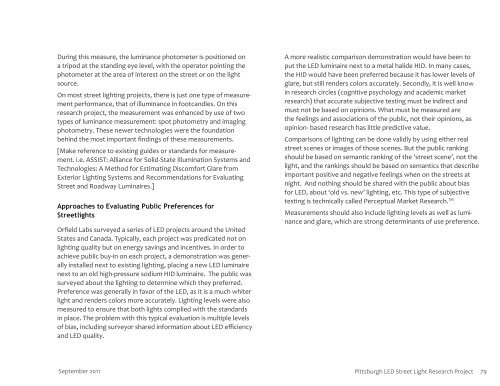LED Street Light Research Project
LED Street Light Research Project
LED Street Light Research Project
You also want an ePaper? Increase the reach of your titles
YUMPU automatically turns print PDFs into web optimized ePapers that Google loves.
During this measure, the luminance photometer is positioned on<br />
a tripod at the standing eye level, with the operator pointing the<br />
photometer at the area of interest on the street or on the light<br />
source.<br />
On most street lighting projects, there is just one type of measurement<br />
performance, that of illuminance in footcandles. On this<br />
research project, the measurement was enhanced by use of two<br />
types of luminance measurement: spot photometry and imaging<br />
photometry. These newer technologies were the foundation<br />
behind the most important findings of these measurements.<br />
[Make reference to existing guides or standards for measurement.<br />
i.e. ASSIST: Alliance for Solid-State Illumination Systems and<br />
Technologies: A Method for Estimating Discomfort Glare from<br />
Exterior <strong>Light</strong>ing Systems and Recommendations for Evaluating<br />
<strong>Street</strong> and Roadway Luminaires.]<br />
Approaches to Evaluating Public Preferences for<br />
<strong>Street</strong>lights<br />
Orfield Labs surveyed a series of <strong>LED</strong> projects around the United<br />
States and Canada. Typically, each project was predicated not on<br />
lighting quality but on energy savings and incentives. In order to<br />
achieve public buy-in on each project, a demonstration was generally<br />
installed next to existing lighting, placing a new <strong>LED</strong> luminaire<br />
next to an old high-pressure sodium HID luminaire. The public was<br />
surveyed about the lighting to determine which they preferred.<br />
Preference was generally in favor of the <strong>LED</strong>, as it is a much whiter<br />
light and renders colors more accurately. <strong>Light</strong>ing levels were also<br />
measured to ensure that both lights complied with the standards<br />
in place. The problem with this typical evaluation is multiple levels<br />
of bias, including surveyor shared information about <strong>LED</strong> efficiency<br />
and <strong>LED</strong> quality.<br />
September 2011<br />
A more realistic comparison demonstration would have been to<br />
put the <strong>LED</strong> luminaire next to a metal halide HID. In many cases,<br />
the HID would have been preferred because it has lower levels of<br />
glare, but still renders colors accurately. Secondly, it is well know<br />
in research circles (cognitive psychology and academic market<br />
research) that accurate subjective testing must be indirect and<br />
must not be based on opinions. What must be measured are<br />
the feelings and associations of the public, not their opinions, as<br />
opinion- based research has little predictive value.<br />
Comparisons of lighting can be done validly by using either real<br />
street scenes or images of those scenes. But the public ranking<br />
should be based on semantic ranking of the ‘street scene’, not the<br />
light, and the rankings should be based on semantics that describe<br />
important positive and negative feelings when on the streets at<br />
night. And nothing should be shared with the public about bias<br />
for <strong>LED</strong>, about ‘old vs. new’ lighting, etc. This type of subjective<br />
testing is technically called Perceptual Market <strong>Research</strong>. TM<br />
Measurements should also include lighting levels as well as luminance<br />
and glare, which are strong determinants of use preference.<br />
Pittsburgh <strong>LED</strong> <strong>Street</strong> <strong>Light</strong> <strong>Research</strong> <strong>Project</strong> 79


